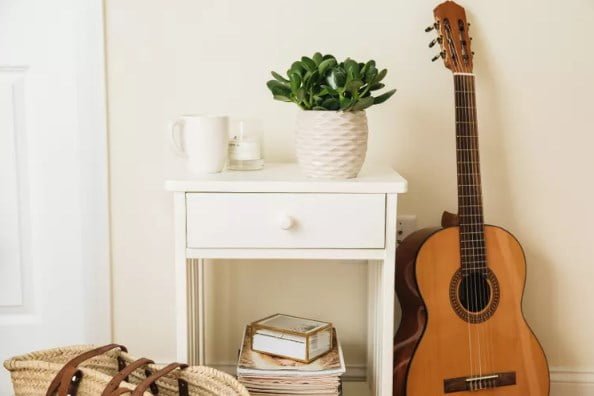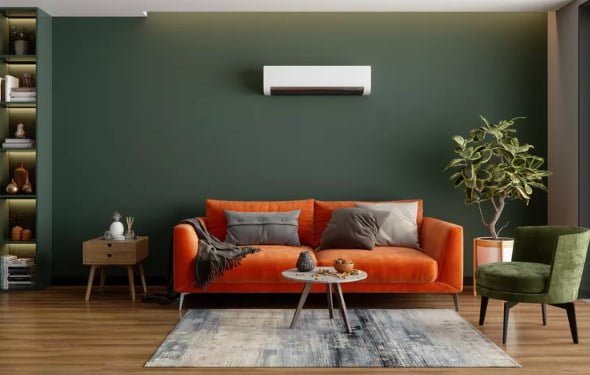Soundproofing a room can be as simple as adding rugs to floors or fabrics, acoustic foam, or acoustic panels to walls. Noise reflects off hard surfaces, like walls, floors, and ceilings, adding to the overall noise level inside a room. Reduce reflected noise by using soft, dense material to absorb the sound. Learn more ideas for how to soundproof a room or space to maintain peace and quiet.
Soundproofing Walls
To soundproof walls, install permanent or non-permanent additions like acoustic panels, acoustic foam, or drywall, or add heavy pieces of furniture like bookcases.

Install Acoustic Panels
Acoustic panels are available as boards or fabrics that you hang on walls to reduce sounds. There are two types: those that stop noise from bouncing off of hard surfaces internally and others that block noise from entering through a door or window.
Install Acoustic Foam
Acoustic foam absorbs sounds in a room by limiting vibrations that cause sound. Acoustic foam panels are made from soft, porous open-cell polyurethane. Sound vibrations that impact acoustic foam lose much or most of their energy. Acoustic foam carries NRC ratings generally from 0.14 to 1.27.
What Is Noise Reduction Coefficient?
Noise Reduction Coefficient, or NRC, measures and rates the ability of a material to absorb sound. The NRC scale ranges from 0 (absorbs no sound) to 1.0 (absorbs all sound). Anomalies in testing processes sometimes return NRC ratings higher than 1.0.
Acoustic foam ranges from 1 inch to 4 inches thick and surface shapes include wedges, pyramids, grids, and egg crates. The shape is less important in limiting sound transmission than the thickness of the acoustic foam.
Sample NRC ratings for wedge-shape acoustic foam:
1 inch: 0.4 NRC
2 inch: 0.65 NRC
3 inch: 0.75 NRC
4 inch: 0.80 NRC
Quadrupling the thickness from 1 inch to 4 inch foam does not quadruple the NRC rating: it only doubles it. So, while thicker acoustic foam does absorb more sound, thinner foam also will appreciably reduce sound and have a better price point.
Add a Bookcase to Muffle Sounds
Bookcases or cabinets can add mass to the wall or partition to effectively reduce sound transmission. Materials and objects of sufficient mass resist vibration and reduce sound transmission.
One idea is to add a wall-to-wall faux built-in to muffle noise from the apartment next door. The ends of the built-in fit should reach (but not) touch the walls, floor, and ceiling. The built-in should not touch the back wall, either. Separating surfaces is a key concept behind soundproofing.

Soundproof With Drywall
Add mass to a room’s walls with heavy, dense building materials like drywall to prevent sound from traveling through thin walls.
Soundproof with conventional drywall or use special soundproofing drywall. With conventional drywall, two sheets can be laid on top of each other. Soundproofing drywall costs more but one layer of this gives you almost as much soundproofing as two layers of conventional drywall.
Soundproofing Doors
To soundproof your door, add weatherproofing to seal gaps around the door where sound may come through and dampen the door itself. Draft stoppers or door sweeps work well for the crack under the door. Curtains can soundproof the door. Replacing hollow-core and other thin doors with solid-core doors is another deterrent against sound.
Hang Door Curtains
Create another layer of soundproofing by hanging heavy blackout curtains over the front door. When closed, the curtains help to absorb any noise that leaks through the door.
Use a Draft Stopper
Place a draft stopper against the gap at the bottom of a door to prevent airborne noise from entering a room.
Draft stoppers—long fabric tubes filled with dense materials—are normally used to limit or prevent cold air from entering rooms during the cold months. But they can also be used for soundproofing. Purchase a draft stopper or make one by filling a long sock with beans and tying off the end.
Soundproofing Windows
Block noises through windows by adding clear window inserts, installing soundproof curtains, or adding weatherstripping or caulk to window gaps.
Install Window Inserts
To block outside noise but not the view, install window inserts. Window inserts are clear panes of glass or acrylic that are placed over existing windows. Inserts create an airtight seal that reduces outside noise. Most inserts can be easily removed when they aren’t needed, making it convenient to open the window for fresh air.
Install Soundproof Curtains
Heavy-duty soundproofing window dressings help prevent outside noises from ruining your sleep. An acoustic curtain for an average-size window can weigh 15 pounds and lies flat against the wall or window trim to block out sound and actually deflect it back outside. Some noise-absorbing curtains glide along tracks for easy opening and closing.
Install Weatherstripping
Close up the cracks and gaps around windows that transmit noises indoors. Cutting down on the airflow into a room reduces sound, and one way to do this is to caulk or add weatherstripping in window cracks. Not only will you reduce external sounds but you will also save energy.
Soundproofing Floors With a Carpet or Rug
A carpet, area rug, or runner—especially with padding—will significantly absorb sound for a quieter room.
Soft floor coverings soundproof a room in two ways: by reducing the sound of traffic and by muffling other noises in the room. Place the area rug in the center of the room. Use carpet runners down hallways or to lead from one room to another.
A shag rug on the ceiling and rubber textile mats on the walls softens annoying noise within the apartment while also absorbing racket from the adjacent units. Slipping a dense rug pad underneath will boost the rug’s noise-squashing potential. This also helps to reduce the din of sounds coming from your downstairs neighbors.
Whenever installing hard flooring such as laminate, make sure that it has an underlayment of polyethylene foam, acoustic foam, or felt.
Soundproofing a Ceiling
To soundproof a ceiling, install non-permanent items like fabrics or permanent devices like ceiling clouds.
Drape fabric over wires stretched between two walls. Attach the wires to eye hooks screwed into studs. Simply remove the fabric and hooks when moving or when soundproofing is no longer needed.
For a more permanent solution, install acoustic ceiling clouds: panels hung parallel to the ceiling that absorb the sound waves.
Add Upholstered Furniture
Upholstered furniture like couches, loveseats, and sectionals can help absorb sound and dampen noises—the larger the piece, the better.
Enhance the soundproofing qualities of upholstered furniture by adding plush pillows and throws.


